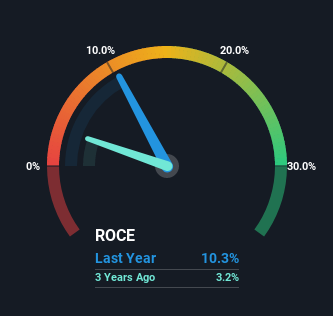- Hong Kong
- /
- Trade Distributors
- /
- SEHK:2866
Returns At COSCO SHIPPING Development (HKG:2866) Are On The Way Up
Finding a business that has the potential to grow substantially is not easy, but it is possible if we look at a few key financial metrics. Amongst other things, we'll want to see two things; firstly, a growing return on capital employed (ROCE) and secondly, an expansion in the company's amount of capital employed. Put simply, these types of businesses are compounding machines, meaning they are continually reinvesting their earnings at ever-higher rates of return. Speaking of which, we noticed some great changes in COSCO SHIPPING Development's (HKG:2866) returns on capital, so let's have a look.
Understanding Return On Capital Employed (ROCE)
If you haven't worked with ROCE before, it measures the 'return' (pre-tax profit) a company generates from capital employed in its business. Analysts use this formula to calculate it for COSCO SHIPPING Development:
Return on Capital Employed = Earnings Before Interest and Tax (EBIT) ÷ (Total Assets - Current Liabilities)
0.10 = CN¥7.8b ÷ (CN¥132b - CN¥56b) (Based on the trailing twelve months to June 2022).
So, COSCO SHIPPING Development has an ROCE of 10%. On its own, that's a standard return, however it's much better than the 4.3% generated by the Trade Distributors industry.
See our latest analysis for COSCO SHIPPING Development

While the past is not representative of the future, it can be helpful to know how a company has performed historically, which is why we have this chart above. If you want to delve into the historical earnings, revenue and cash flow of COSCO SHIPPING Development, check out these free graphs here.
How Are Returns Trending?
COSCO SHIPPING Development has not disappointed with their ROCE growth. Looking at the data, we can see that even though capital employed in the business has remained relatively flat, the ROCE generated has risen by 340% over the last five years. Basically the business is generating higher returns from the same amount of capital and that is proof that there are improvements in the company's efficiencies. It's worth looking deeper into this though because while it's great that the business is more efficient, it might also mean that going forward the areas to invest internally for the organic growth are lacking.
On a separate but related note, it's important to know that COSCO SHIPPING Development has a current liabilities to total assets ratio of 43%, which we'd consider pretty high. This can bring about some risks because the company is basically operating with a rather large reliance on its suppliers or other sorts of short-term creditors. While it's not necessarily a bad thing, it can be beneficial if this ratio is lower.
In Conclusion...
As discussed above, COSCO SHIPPING Development appears to be getting more proficient at generating returns since capital employed has remained flat but earnings (before interest and tax) are up. Astute investors may have an opportunity here because the stock has declined 17% in the last five years. So researching this company further and determining whether or not these trends will continue seems justified.
If you'd like to know more about COSCO SHIPPING Development, we've spotted 3 warning signs, and 1 of them makes us a bit uncomfortable.
While COSCO SHIPPING Development isn't earning the highest return, check out this free list of companies that are earning high returns on equity with solid balance sheets.
New: AI Stock Screener & Alerts
Our new AI Stock Screener scans the market every day to uncover opportunities.
• Dividend Powerhouses (3%+ Yield)
• Undervalued Small Caps with Insider Buying
• High growth Tech and AI Companies
Or build your own from over 50 metrics.
Have feedback on this article? Concerned about the content? Get in touch with us directly. Alternatively, email editorial-team (at) simplywallst.com.
This article by Simply Wall St is general in nature. We provide commentary based on historical data and analyst forecasts only using an unbiased methodology and our articles are not intended to be financial advice. It does not constitute a recommendation to buy or sell any stock, and does not take account of your objectives, or your financial situation. We aim to bring you long-term focused analysis driven by fundamental data. Note that our analysis may not factor in the latest price-sensitive company announcements or qualitative material. Simply Wall St has no position in any stocks mentioned.
About SEHK:2866
COSCO SHIPPING Development
Researches, develops, manufactures, and sells containers in the United States, Asia, Hong Kong, Mainland China, Europe, and internationally.
Proven track record with low risk.
Similar Companies
Market Insights
Community Narratives



